Case Study: Ethical Decision-Making in Adolescent Counselling
VerifiedAdded on 2022/09/28
|12
|2790
|25
Case Study
AI Summary
This case study examines the ethical challenges faced by a counsellor working with an adolescent boy, Joe, focusing on issues such as confidentiality, parental involvement, and potential conflicts between the patient's welfare and the counsellor's professional obligations. The study identifies ethical dilemmas related to family counselling, access to patient information by family members and the school, and the potential consequences of revealing sensitive information. It explores ethical traps, including objectivity, value, and circumstantiality traps, and analyzes the preliminary responses and possible consequences of various decisions. The paper also discusses ethical resolution strategies, emphasizing the importance of adhering to ethical codes, obtaining informed consent, and considering the principles of autonomy, non-maleficence, beneficence, justice, and fidelity. The study highlights the importance of proactive planning, compliance with ethical guidelines, and seeking common ground to ensure the best outcomes for the patient.
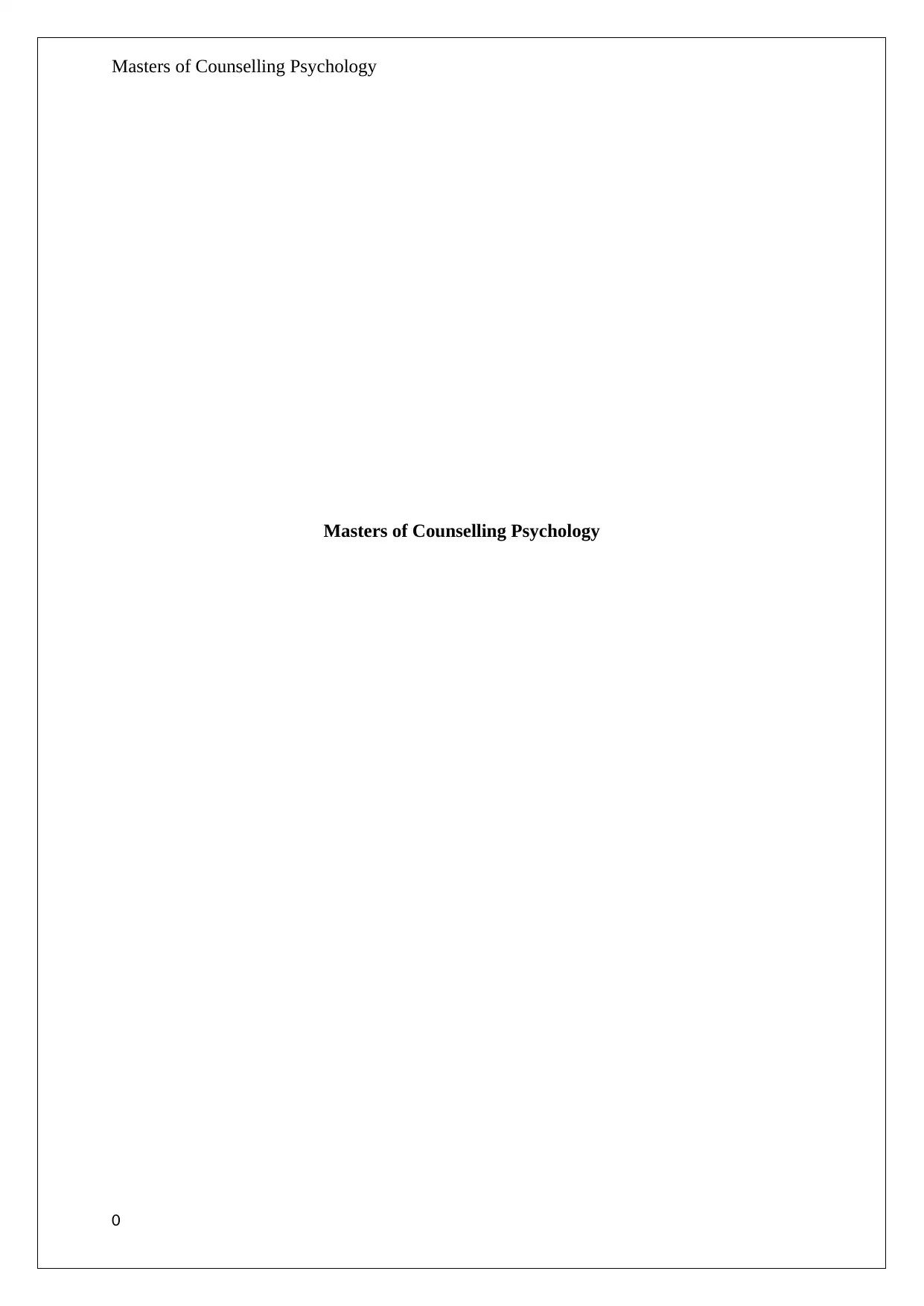
Masters of Counselling Psychology
Masters of Counselling Psychology
0
Masters of Counselling Psychology
0
Paraphrase This Document
Need a fresh take? Get an instant paraphrase of this document with our AI Paraphraser
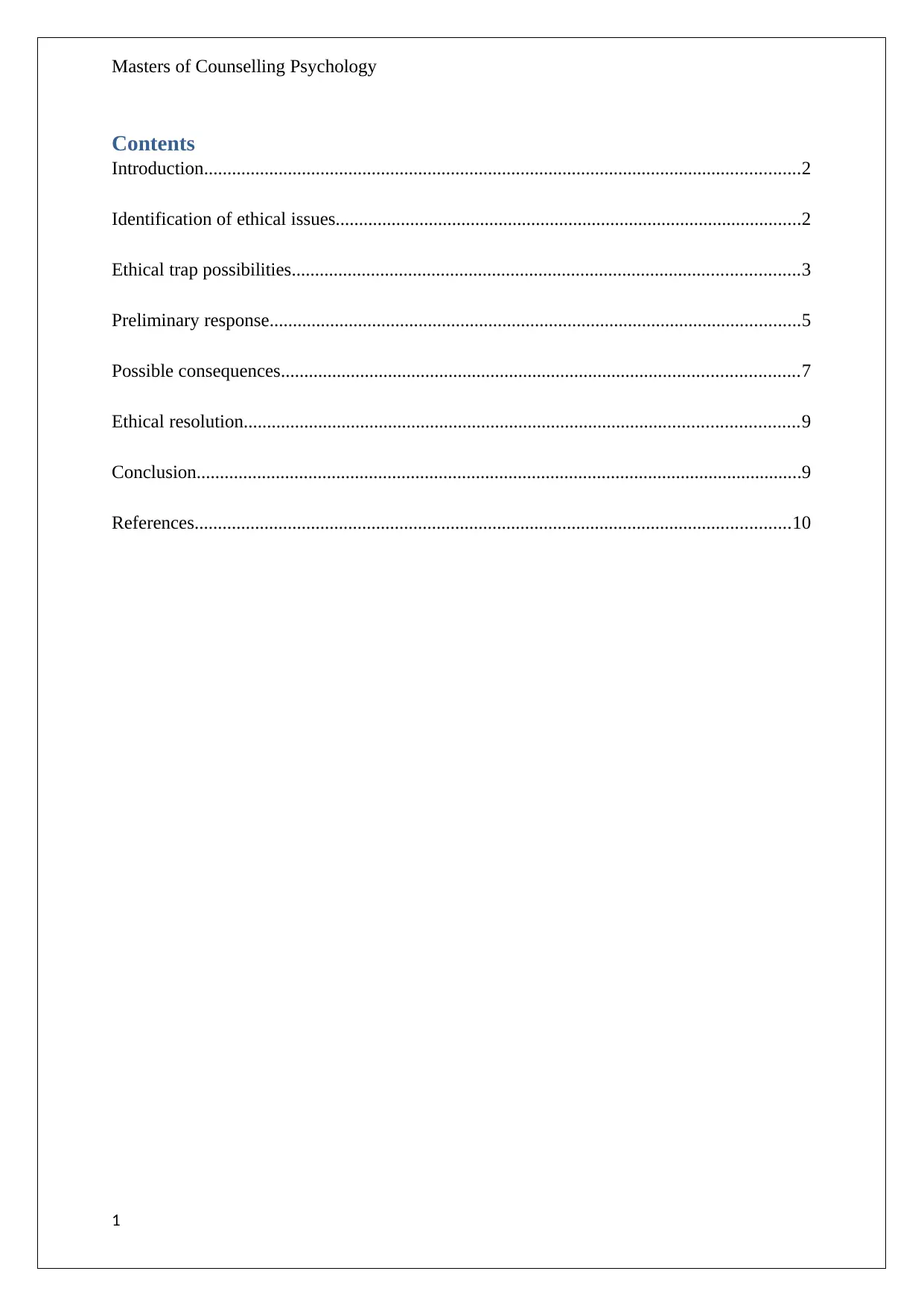
Masters of Counselling Psychology
Contents
Introduction................................................................................................................................2
Identification of ethical issues....................................................................................................2
Ethical trap possibilities.............................................................................................................3
Preliminary response..................................................................................................................5
Possible consequences...............................................................................................................7
Ethical resolution.......................................................................................................................9
Conclusion..................................................................................................................................9
References................................................................................................................................10
1
Contents
Introduction................................................................................................................................2
Identification of ethical issues....................................................................................................2
Ethical trap possibilities.............................................................................................................3
Preliminary response..................................................................................................................5
Possible consequences...............................................................................................................7
Ethical resolution.......................................................................................................................9
Conclusion..................................................................................................................................9
References................................................................................................................................10
1
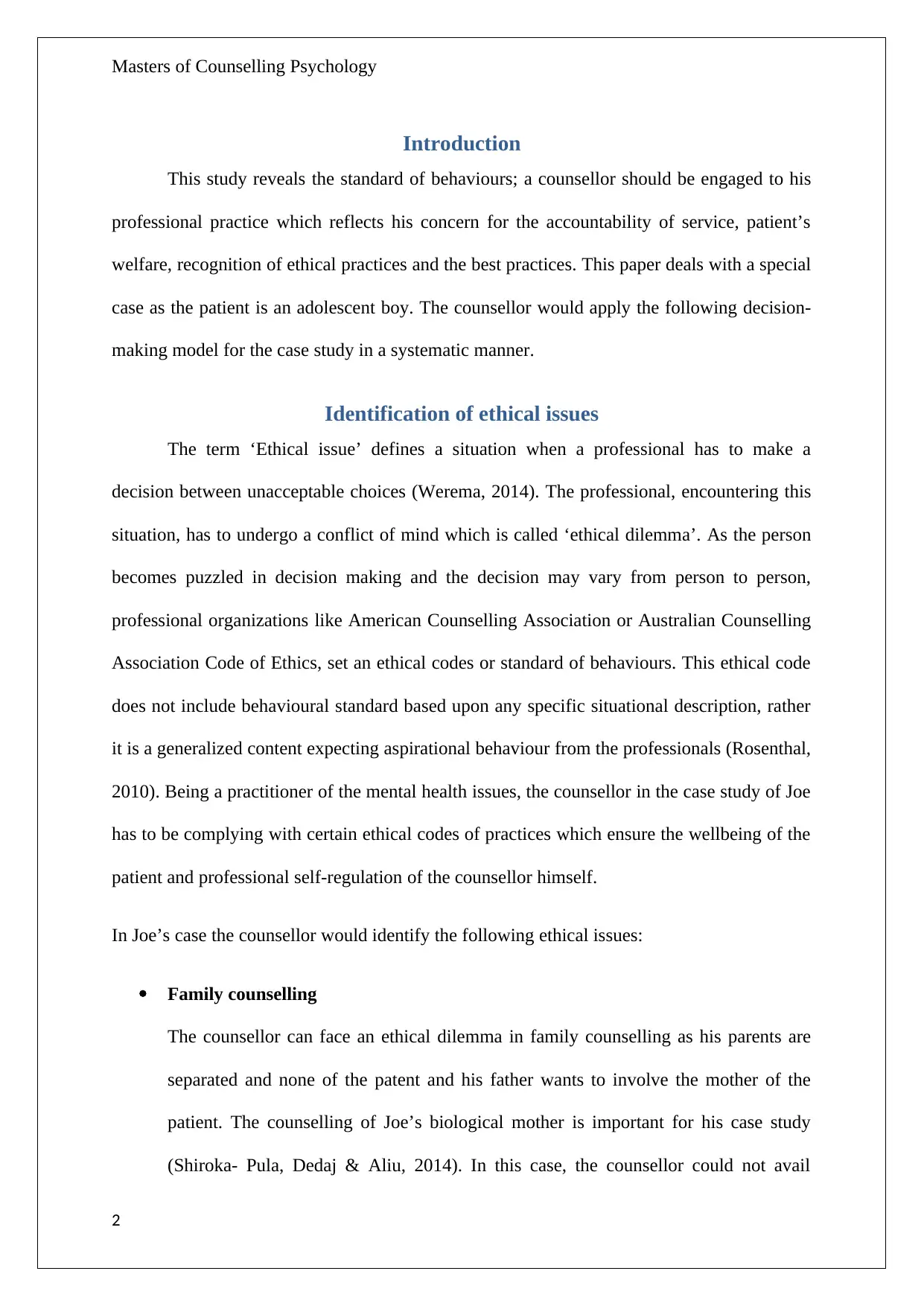
Masters of Counselling Psychology
Introduction
This study reveals the standard of behaviours; a counsellor should be engaged to his
professional practice which reflects his concern for the accountability of service, patient’s
welfare, recognition of ethical practices and the best practices. This paper deals with a special
case as the patient is an adolescent boy. The counsellor would apply the following decision-
making model for the case study in a systematic manner.
Identification of ethical issues
The term ‘Ethical issue’ defines a situation when a professional has to make a
decision between unacceptable choices (Werema, 2014). The professional, encountering this
situation, has to undergo a conflict of mind which is called ‘ethical dilemma’. As the person
becomes puzzled in decision making and the decision may vary from person to person,
professional organizations like American Counselling Association or Australian Counselling
Association Code of Ethics, set an ethical codes or standard of behaviours. This ethical code
does not include behavioural standard based upon any specific situational description, rather
it is a generalized content expecting aspirational behaviour from the professionals (Rosenthal,
2010). Being a practitioner of the mental health issues, the counsellor in the case study of Joe
has to be complying with certain ethical codes of practices which ensure the wellbeing of the
patient and professional self-regulation of the counsellor himself.
In Joe’s case the counsellor would identify the following ethical issues:
Family counselling
The counsellor can face an ethical dilemma in family counselling as his parents are
separated and none of the patent and his father wants to involve the mother of the
patient. The counselling of Joe’s biological mother is important for his case study
(Shiroka- Pula, Dedaj & Aliu, 2014). In this case, the counsellor could not avail
2
Introduction
This study reveals the standard of behaviours; a counsellor should be engaged to his
professional practice which reflects his concern for the accountability of service, patient’s
welfare, recognition of ethical practices and the best practices. This paper deals with a special
case as the patient is an adolescent boy. The counsellor would apply the following decision-
making model for the case study in a systematic manner.
Identification of ethical issues
The term ‘Ethical issue’ defines a situation when a professional has to make a
decision between unacceptable choices (Werema, 2014). The professional, encountering this
situation, has to undergo a conflict of mind which is called ‘ethical dilemma’. As the person
becomes puzzled in decision making and the decision may vary from person to person,
professional organizations like American Counselling Association or Australian Counselling
Association Code of Ethics, set an ethical codes or standard of behaviours. This ethical code
does not include behavioural standard based upon any specific situational description, rather
it is a generalized content expecting aspirational behaviour from the professionals (Rosenthal,
2010). Being a practitioner of the mental health issues, the counsellor in the case study of Joe
has to be complying with certain ethical codes of practices which ensure the wellbeing of the
patient and professional self-regulation of the counsellor himself.
In Joe’s case the counsellor would identify the following ethical issues:
Family counselling
The counsellor can face an ethical dilemma in family counselling as his parents are
separated and none of the patent and his father wants to involve the mother of the
patient. The counselling of Joe’s biological mother is important for his case study
(Shiroka- Pula, Dedaj & Aliu, 2014). In this case, the counsellor could not avail
2
⊘ This is a preview!⊘
Do you want full access?
Subscribe today to unlock all pages.

Trusted by 1+ million students worldwide
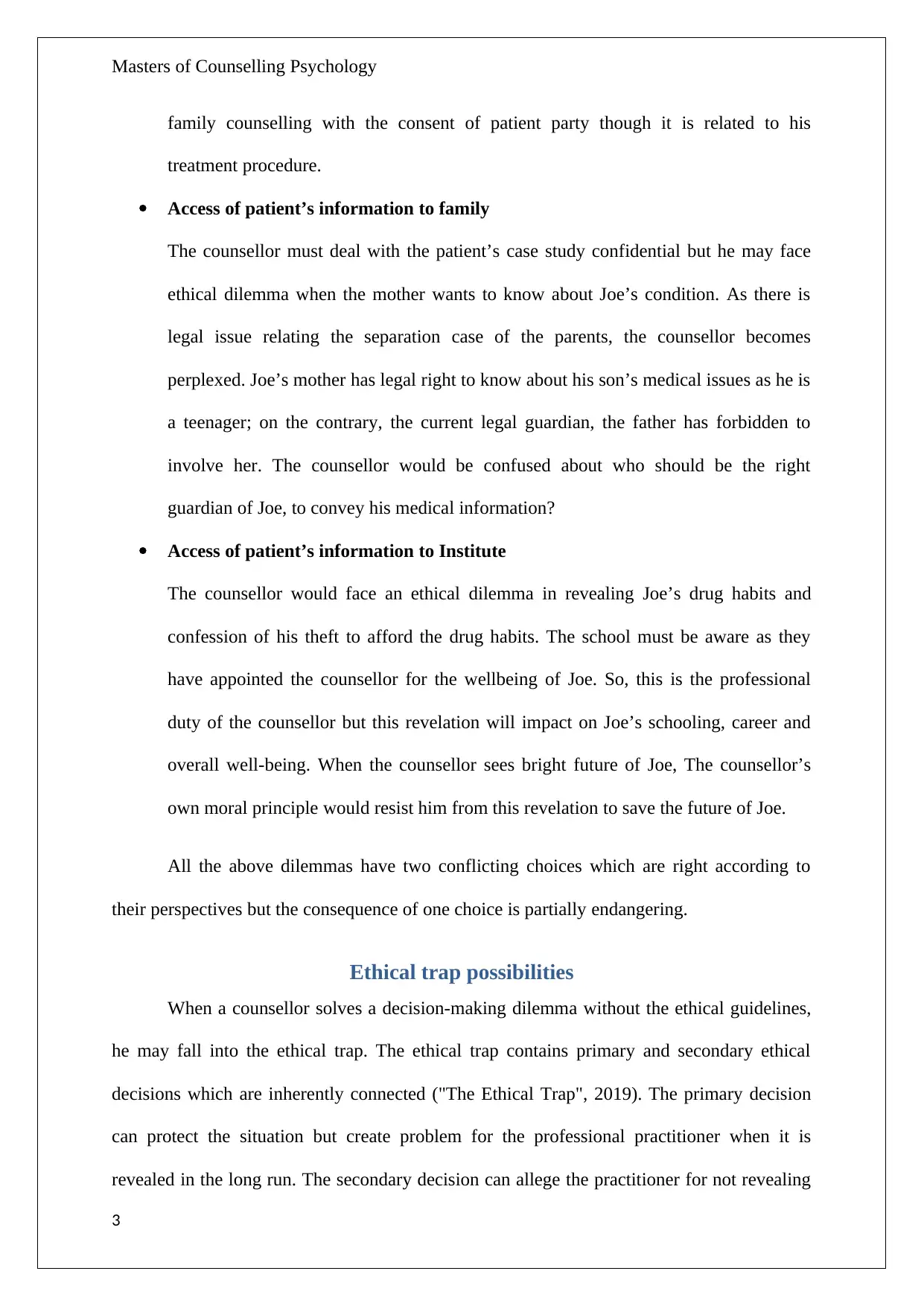
Masters of Counselling Psychology
family counselling with the consent of patient party though it is related to his
treatment procedure.
Access of patient’s information to family
The counsellor must deal with the patient’s case study confidential but he may face
ethical dilemma when the mother wants to know about Joe’s condition. As there is
legal issue relating the separation case of the parents, the counsellor becomes
perplexed. Joe’s mother has legal right to know about his son’s medical issues as he is
a teenager; on the contrary, the current legal guardian, the father has forbidden to
involve her. The counsellor would be confused about who should be the right
guardian of Joe, to convey his medical information?
Access of patient’s information to Institute
The counsellor would face an ethical dilemma in revealing Joe’s drug habits and
confession of his theft to afford the drug habits. The school must be aware as they
have appointed the counsellor for the wellbeing of Joe. So, this is the professional
duty of the counsellor but this revelation will impact on Joe’s schooling, career and
overall well-being. When the counsellor sees bright future of Joe, The counsellor’s
own moral principle would resist him from this revelation to save the future of Joe.
All the above dilemmas have two conflicting choices which are right according to
their perspectives but the consequence of one choice is partially endangering.
Ethical trap possibilities
When a counsellor solves a decision-making dilemma without the ethical guidelines,
he may fall into the ethical trap. The ethical trap contains primary and secondary ethical
decisions which are inherently connected ("The Ethical Trap", 2019). The primary decision
can protect the situation but create problem for the professional practitioner when it is
revealed in the long run. The secondary decision can allege the practitioner for not revealing
3
family counselling with the consent of patient party though it is related to his
treatment procedure.
Access of patient’s information to family
The counsellor must deal with the patient’s case study confidential but he may face
ethical dilemma when the mother wants to know about Joe’s condition. As there is
legal issue relating the separation case of the parents, the counsellor becomes
perplexed. Joe’s mother has legal right to know about his son’s medical issues as he is
a teenager; on the contrary, the current legal guardian, the father has forbidden to
involve her. The counsellor would be confused about who should be the right
guardian of Joe, to convey his medical information?
Access of patient’s information to Institute
The counsellor would face an ethical dilemma in revealing Joe’s drug habits and
confession of his theft to afford the drug habits. The school must be aware as they
have appointed the counsellor for the wellbeing of Joe. So, this is the professional
duty of the counsellor but this revelation will impact on Joe’s schooling, career and
overall well-being. When the counsellor sees bright future of Joe, The counsellor’s
own moral principle would resist him from this revelation to save the future of Joe.
All the above dilemmas have two conflicting choices which are right according to
their perspectives but the consequence of one choice is partially endangering.
Ethical trap possibilities
When a counsellor solves a decision-making dilemma without the ethical guidelines,
he may fall into the ethical trap. The ethical trap contains primary and secondary ethical
decisions which are inherently connected ("The Ethical Trap", 2019). The primary decision
can protect the situation but create problem for the professional practitioner when it is
revealed in the long run. The secondary decision can allege the practitioner for not revealing
3
Paraphrase This Document
Need a fresh take? Get an instant paraphrase of this document with our AI Paraphraser
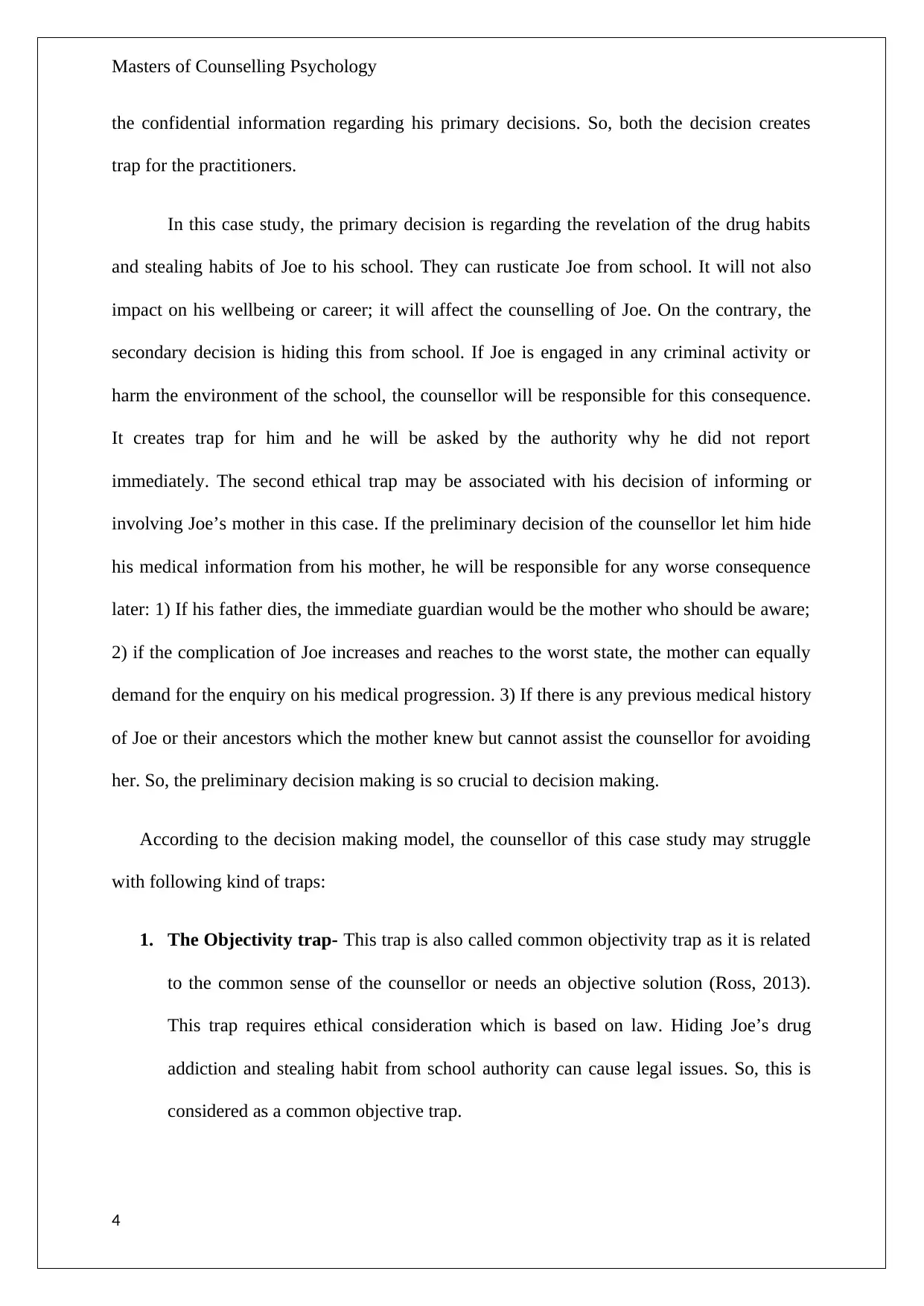
Masters of Counselling Psychology
the confidential information regarding his primary decisions. So, both the decision creates
trap for the practitioners.
In this case study, the primary decision is regarding the revelation of the drug habits
and stealing habits of Joe to his school. They can rusticate Joe from school. It will not also
impact on his wellbeing or career; it will affect the counselling of Joe. On the contrary, the
secondary decision is hiding this from school. If Joe is engaged in any criminal activity or
harm the environment of the school, the counsellor will be responsible for this consequence.
It creates trap for him and he will be asked by the authority why he did not report
immediately. The second ethical trap may be associated with his decision of informing or
involving Joe’s mother in this case. If the preliminary decision of the counsellor let him hide
his medical information from his mother, he will be responsible for any worse consequence
later: 1) If his father dies, the immediate guardian would be the mother who should be aware;
2) if the complication of Joe increases and reaches to the worst state, the mother can equally
demand for the enquiry on his medical progression. 3) If there is any previous medical history
of Joe or their ancestors which the mother knew but cannot assist the counsellor for avoiding
her. So, the preliminary decision making is so crucial to decision making.
According to the decision making model, the counsellor of this case study may struggle
with following kind of traps:
1. The Objectivity trap- This trap is also called common objectivity trap as it is related
to the common sense of the counsellor or needs an objective solution (Ross, 2013).
This trap requires ethical consideration which is based on law. Hiding Joe’s drug
addiction and stealing habit from school authority can cause legal issues. So, this is
considered as a common objective trap.
4
the confidential information regarding his primary decisions. So, both the decision creates
trap for the practitioners.
In this case study, the primary decision is regarding the revelation of the drug habits
and stealing habits of Joe to his school. They can rusticate Joe from school. It will not also
impact on his wellbeing or career; it will affect the counselling of Joe. On the contrary, the
secondary decision is hiding this from school. If Joe is engaged in any criminal activity or
harm the environment of the school, the counsellor will be responsible for this consequence.
It creates trap for him and he will be asked by the authority why he did not report
immediately. The second ethical trap may be associated with his decision of informing or
involving Joe’s mother in this case. If the preliminary decision of the counsellor let him hide
his medical information from his mother, he will be responsible for any worse consequence
later: 1) If his father dies, the immediate guardian would be the mother who should be aware;
2) if the complication of Joe increases and reaches to the worst state, the mother can equally
demand for the enquiry on his medical progression. 3) If there is any previous medical history
of Joe or their ancestors which the mother knew but cannot assist the counsellor for avoiding
her. So, the preliminary decision making is so crucial to decision making.
According to the decision making model, the counsellor of this case study may struggle
with following kind of traps:
1. The Objectivity trap- This trap is also called common objectivity trap as it is related
to the common sense of the counsellor or needs an objective solution (Ross, 2013).
This trap requires ethical consideration which is based on law. Hiding Joe’s drug
addiction and stealing habit from school authority can cause legal issues. So, this is
considered as a common objective trap.
4
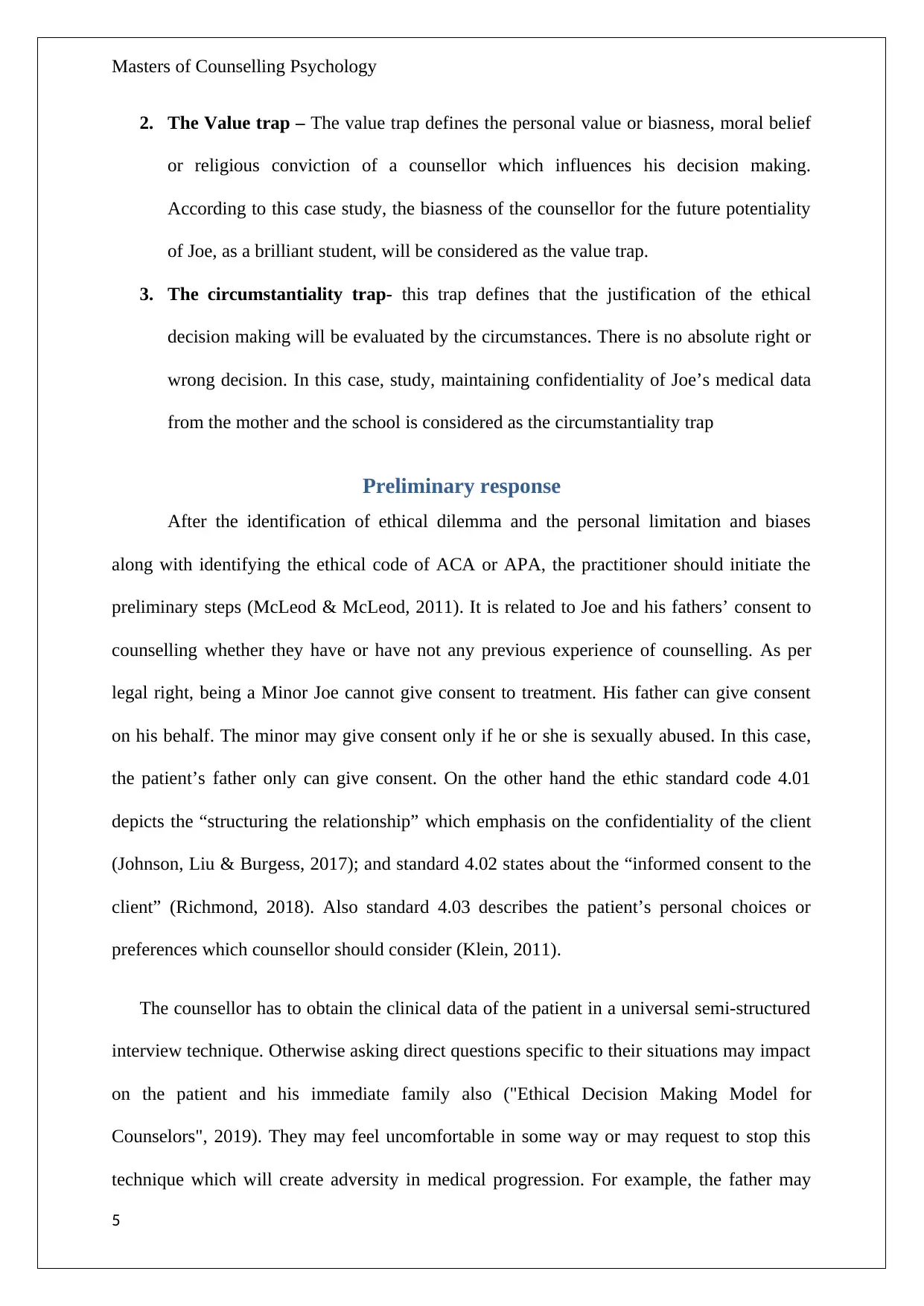
Masters of Counselling Psychology
2. The Value trap – The value trap defines the personal value or biasness, moral belief
or religious conviction of a counsellor which influences his decision making.
According to this case study, the biasness of the counsellor for the future potentiality
of Joe, as a brilliant student, will be considered as the value trap.
3. The circumstantiality trap- this trap defines that the justification of the ethical
decision making will be evaluated by the circumstances. There is no absolute right or
wrong decision. In this case, study, maintaining confidentiality of Joe’s medical data
from the mother and the school is considered as the circumstantiality trap
Preliminary response
After the identification of ethical dilemma and the personal limitation and biases
along with identifying the ethical code of ACA or APA, the practitioner should initiate the
preliminary steps (McLeod & McLeod, 2011). It is related to Joe and his fathers’ consent to
counselling whether they have or have not any previous experience of counselling. As per
legal right, being a Minor Joe cannot give consent to treatment. His father can give consent
on his behalf. The minor may give consent only if he or she is sexually abused. In this case,
the patient’s father only can give consent. On the other hand the ethic standard code 4.01
depicts the “structuring the relationship” which emphasis on the confidentiality of the client
(Johnson, Liu & Burgess, 2017); and standard 4.02 states about the “informed consent to the
client” (Richmond, 2018). Also standard 4.03 describes the patient’s personal choices or
preferences which counsellor should consider (Klein, 2011).
The counsellor has to obtain the clinical data of the patient in a universal semi-structured
interview technique. Otherwise asking direct questions specific to their situations may impact
on the patient and his immediate family also ("Ethical Decision Making Model for
Counselors", 2019). They may feel uncomfortable in some way or may request to stop this
technique which will create adversity in medical progression. For example, the father may
5
2. The Value trap – The value trap defines the personal value or biasness, moral belief
or religious conviction of a counsellor which influences his decision making.
According to this case study, the biasness of the counsellor for the future potentiality
of Joe, as a brilliant student, will be considered as the value trap.
3. The circumstantiality trap- this trap defines that the justification of the ethical
decision making will be evaluated by the circumstances. There is no absolute right or
wrong decision. In this case, study, maintaining confidentiality of Joe’s medical data
from the mother and the school is considered as the circumstantiality trap
Preliminary response
After the identification of ethical dilemma and the personal limitation and biases
along with identifying the ethical code of ACA or APA, the practitioner should initiate the
preliminary steps (McLeod & McLeod, 2011). It is related to Joe and his fathers’ consent to
counselling whether they have or have not any previous experience of counselling. As per
legal right, being a Minor Joe cannot give consent to treatment. His father can give consent
on his behalf. The minor may give consent only if he or she is sexually abused. In this case,
the patient’s father only can give consent. On the other hand the ethic standard code 4.01
depicts the “structuring the relationship” which emphasis on the confidentiality of the client
(Johnson, Liu & Burgess, 2017); and standard 4.02 states about the “informed consent to the
client” (Richmond, 2018). Also standard 4.03 describes the patient’s personal choices or
preferences which counsellor should consider (Klein, 2011).
The counsellor has to obtain the clinical data of the patient in a universal semi-structured
interview technique. Otherwise asking direct questions specific to their situations may impact
on the patient and his immediate family also ("Ethical Decision Making Model for
Counselors", 2019). They may feel uncomfortable in some way or may request to stop this
technique which will create adversity in medical progression. For example, the father may
5
⊘ This is a preview!⊘
Do you want full access?
Subscribe today to unlock all pages.

Trusted by 1+ million students worldwide
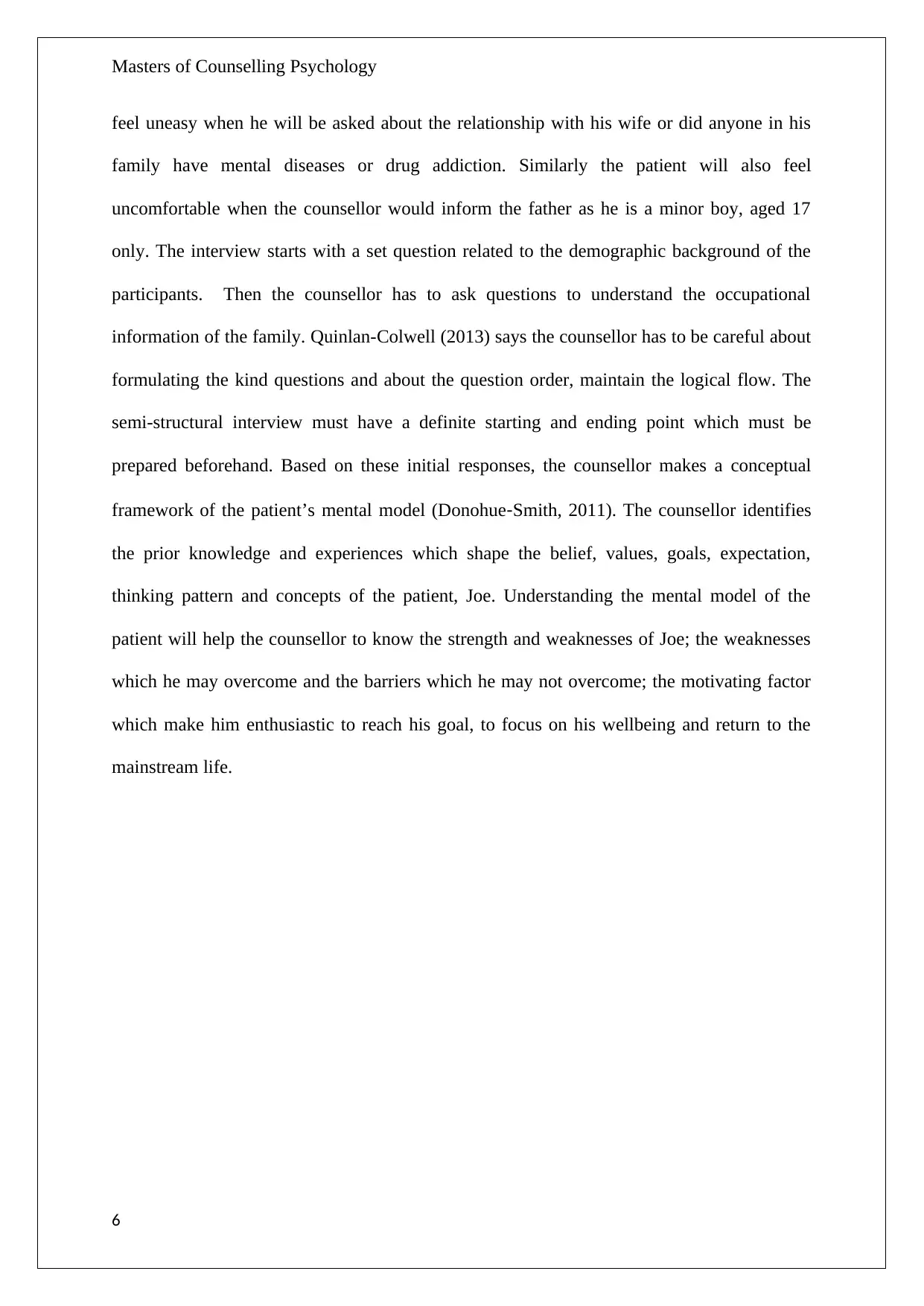
Masters of Counselling Psychology
feel uneasy when he will be asked about the relationship with his wife or did anyone in his
family have mental diseases or drug addiction. Similarly the patient will also feel
uncomfortable when the counsellor would inform the father as he is a minor boy, aged 17
only. The interview starts with a set question related to the demographic background of the
participants. Then the counsellor has to ask questions to understand the occupational
information of the family. Quinlan-Colwell (2013) says the counsellor has to be careful about
formulating the kind questions and about the question order, maintain the logical flow. The
semi-structural interview must have a definite starting and ending point which must be
prepared beforehand. Based on these initial responses, the counsellor makes a conceptual
framework of the patient’s mental model (Donohue‐Smith, 2011). The counsellor identifies
the prior knowledge and experiences which shape the belief, values, goals, expectation,
thinking pattern and concepts of the patient, Joe. Understanding the mental model of the
patient will help the counsellor to know the strength and weaknesses of Joe; the weaknesses
which he may overcome and the barriers which he may not overcome; the motivating factor
which make him enthusiastic to reach his goal, to focus on his wellbeing and return to the
mainstream life.
6
feel uneasy when he will be asked about the relationship with his wife or did anyone in his
family have mental diseases or drug addiction. Similarly the patient will also feel
uncomfortable when the counsellor would inform the father as he is a minor boy, aged 17
only. The interview starts with a set question related to the demographic background of the
participants. Then the counsellor has to ask questions to understand the occupational
information of the family. Quinlan-Colwell (2013) says the counsellor has to be careful about
formulating the kind questions and about the question order, maintain the logical flow. The
semi-structural interview must have a definite starting and ending point which must be
prepared beforehand. Based on these initial responses, the counsellor makes a conceptual
framework of the patient’s mental model (Donohue‐Smith, 2011). The counsellor identifies
the prior knowledge and experiences which shape the belief, values, goals, expectation,
thinking pattern and concepts of the patient, Joe. Understanding the mental model of the
patient will help the counsellor to know the strength and weaknesses of Joe; the weaknesses
which he may overcome and the barriers which he may not overcome; the motivating factor
which make him enthusiastic to reach his goal, to focus on his wellbeing and return to the
mainstream life.
6
Paraphrase This Document
Need a fresh take? Get an instant paraphrase of this document with our AI Paraphraser
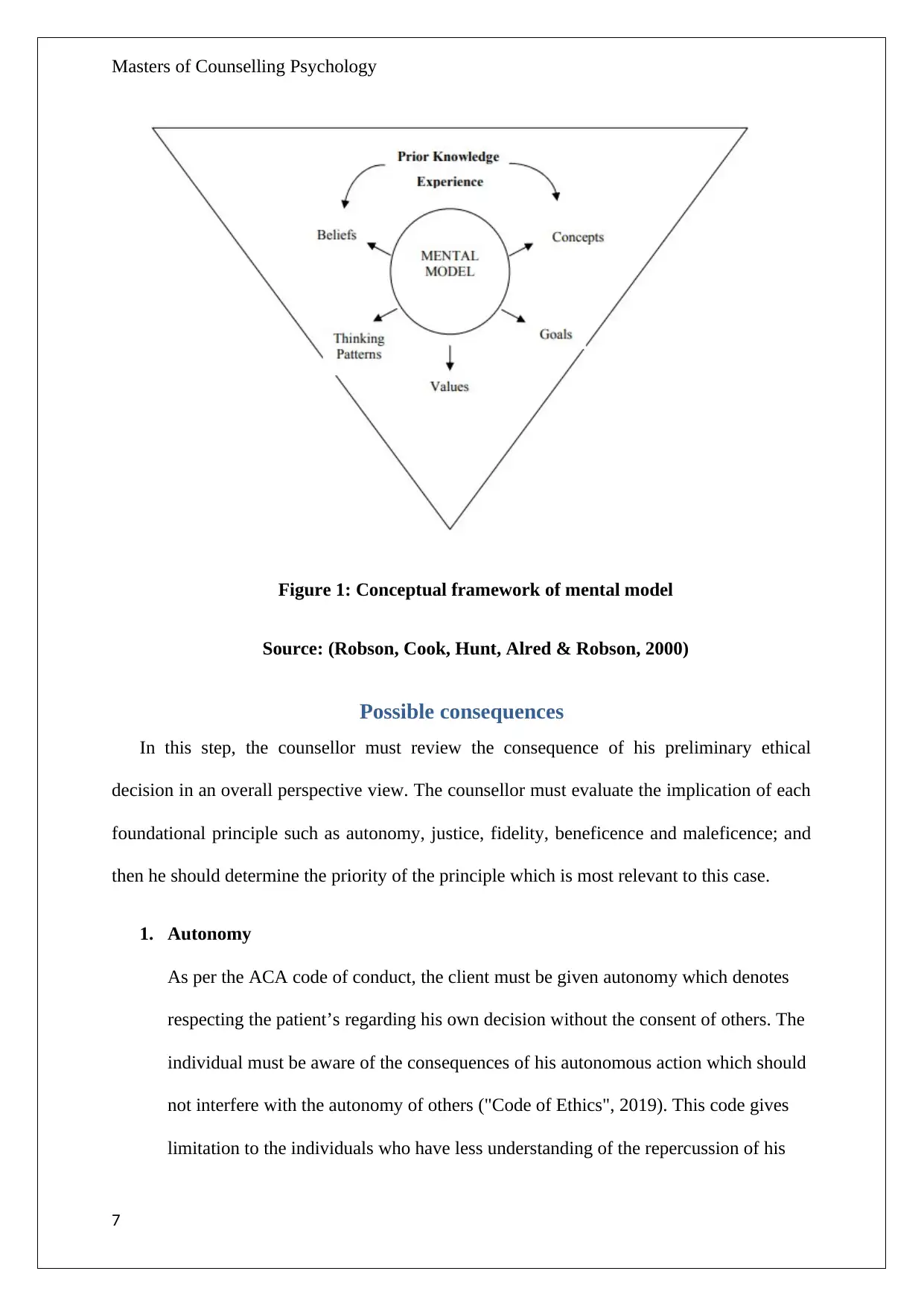
Masters of Counselling Psychology
Figure 1: Conceptual framework of mental model
Source: (Robson, Cook, Hunt, Alred & Robson, 2000)
Possible consequences
In this step, the counsellor must review the consequence of his preliminary ethical
decision in an overall perspective view. The counsellor must evaluate the implication of each
foundational principle such as autonomy, justice, fidelity, beneficence and maleficence; and
then he should determine the priority of the principle which is most relevant to this case.
1. Autonomy
As per the ACA code of conduct, the client must be given autonomy which denotes
respecting the patient’s regarding his own decision without the consent of others. The
individual must be aware of the consequences of his autonomous action which should
not interfere with the autonomy of others ("Code of Ethics", 2019). This code gives
limitation to the individuals who have less understanding of the repercussion of his
7
Figure 1: Conceptual framework of mental model
Source: (Robson, Cook, Hunt, Alred & Robson, 2000)
Possible consequences
In this step, the counsellor must review the consequence of his preliminary ethical
decision in an overall perspective view. The counsellor must evaluate the implication of each
foundational principle such as autonomy, justice, fidelity, beneficence and maleficence; and
then he should determine the priority of the principle which is most relevant to this case.
1. Autonomy
As per the ACA code of conduct, the client must be given autonomy which denotes
respecting the patient’s regarding his own decision without the consent of others. The
individual must be aware of the consequences of his autonomous action which should
not interfere with the autonomy of others ("Code of Ethics", 2019). This code gives
limitation to the individuals who have less understanding of the repercussion of his
7
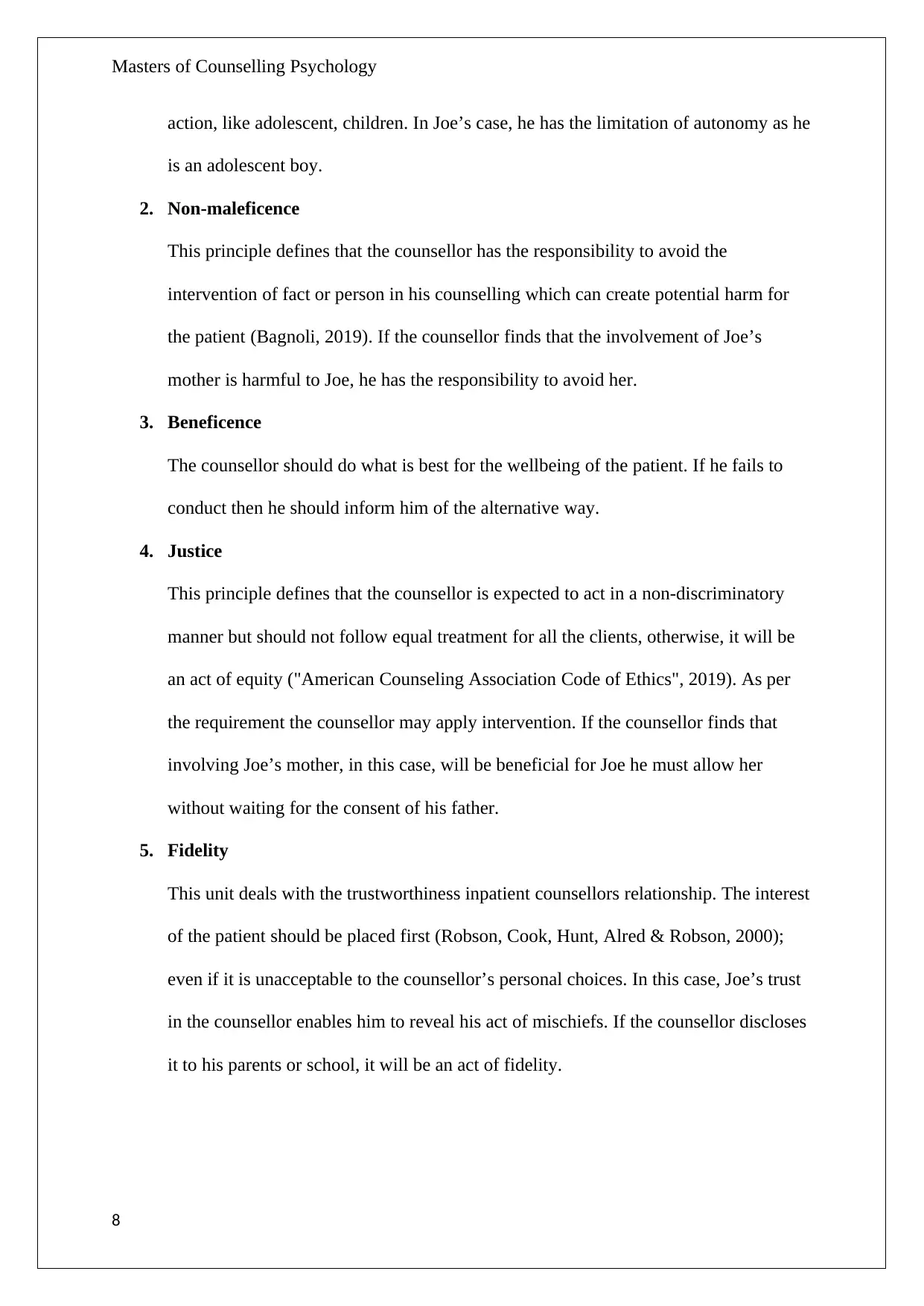
Masters of Counselling Psychology
action, like adolescent, children. In Joe’s case, he has the limitation of autonomy as he
is an adolescent boy.
2. Non-maleficence
This principle defines that the counsellor has the responsibility to avoid the
intervention of fact or person in his counselling which can create potential harm for
the patient (Bagnoli, 2019). If the counsellor finds that the involvement of Joe’s
mother is harmful to Joe, he has the responsibility to avoid her.
3. Beneficence
The counsellor should do what is best for the wellbeing of the patient. If he fails to
conduct then he should inform him of the alternative way.
4. Justice
This principle defines that the counsellor is expected to act in a non-discriminatory
manner but should not follow equal treatment for all the clients, otherwise, it will be
an act of equity ("American Counseling Association Code of Ethics", 2019). As per
the requirement the counsellor may apply intervention. If the counsellor finds that
involving Joe’s mother, in this case, will be beneficial for Joe he must allow her
without waiting for the consent of his father.
5. Fidelity
This unit deals with the trustworthiness inpatient counsellors relationship. The interest
of the patient should be placed first (Robson, Cook, Hunt, Alred & Robson, 2000);
even if it is unacceptable to the counsellor’s personal choices. In this case, Joe’s trust
in the counsellor enables him to reveal his act of mischiefs. If the counsellor discloses
it to his parents or school, it will be an act of fidelity.
8
action, like adolescent, children. In Joe’s case, he has the limitation of autonomy as he
is an adolescent boy.
2. Non-maleficence
This principle defines that the counsellor has the responsibility to avoid the
intervention of fact or person in his counselling which can create potential harm for
the patient (Bagnoli, 2019). If the counsellor finds that the involvement of Joe’s
mother is harmful to Joe, he has the responsibility to avoid her.
3. Beneficence
The counsellor should do what is best for the wellbeing of the patient. If he fails to
conduct then he should inform him of the alternative way.
4. Justice
This principle defines that the counsellor is expected to act in a non-discriminatory
manner but should not follow equal treatment for all the clients, otherwise, it will be
an act of equity ("American Counseling Association Code of Ethics", 2019). As per
the requirement the counsellor may apply intervention. If the counsellor finds that
involving Joe’s mother, in this case, will be beneficial for Joe he must allow her
without waiting for the consent of his father.
5. Fidelity
This unit deals with the trustworthiness inpatient counsellors relationship. The interest
of the patient should be placed first (Robson, Cook, Hunt, Alred & Robson, 2000);
even if it is unacceptable to the counsellor’s personal choices. In this case, Joe’s trust
in the counsellor enables him to reveal his act of mischiefs. If the counsellor discloses
it to his parents or school, it will be an act of fidelity.
8
⊘ This is a preview!⊘
Do you want full access?
Subscribe today to unlock all pages.

Trusted by 1+ million students worldwide
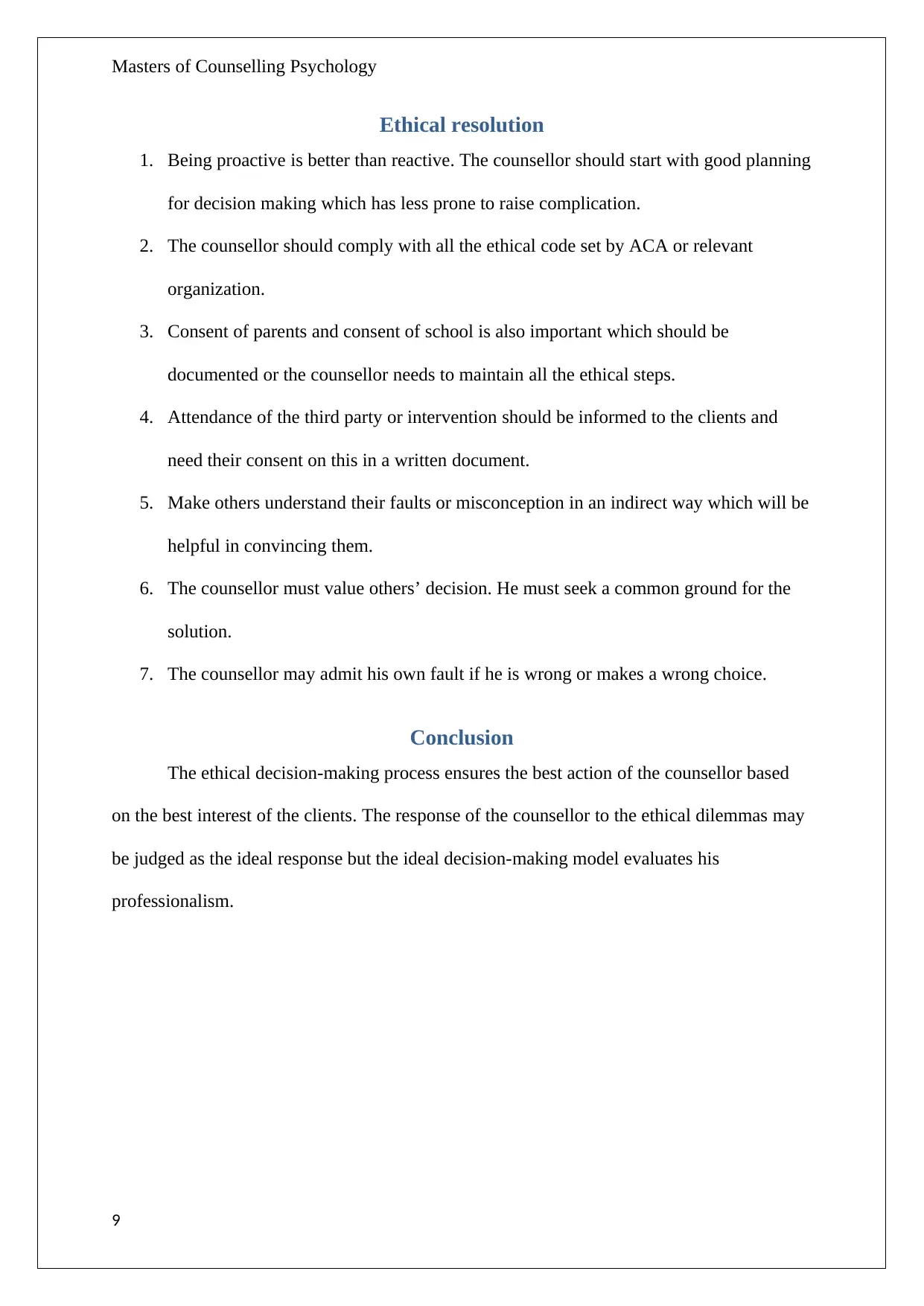
Masters of Counselling Psychology
Ethical resolution
1. Being proactive is better than reactive. The counsellor should start with good planning
for decision making which has less prone to raise complication.
2. The counsellor should comply with all the ethical code set by ACA or relevant
organization.
3. Consent of parents and consent of school is also important which should be
documented or the counsellor needs to maintain all the ethical steps.
4. Attendance of the third party or intervention should be informed to the clients and
need their consent on this in a written document.
5. Make others understand their faults or misconception in an indirect way which will be
helpful in convincing them.
6. The counsellor must value others’ decision. He must seek a common ground for the
solution.
7. The counsellor may admit his own fault if he is wrong or makes a wrong choice.
Conclusion
The ethical decision-making process ensures the best action of the counsellor based
on the best interest of the clients. The response of the counsellor to the ethical dilemmas may
be judged as the ideal response but the ideal decision-making model evaluates his
professionalism.
9
Ethical resolution
1. Being proactive is better than reactive. The counsellor should start with good planning
for decision making which has less prone to raise complication.
2. The counsellor should comply with all the ethical code set by ACA or relevant
organization.
3. Consent of parents and consent of school is also important which should be
documented or the counsellor needs to maintain all the ethical steps.
4. Attendance of the third party or intervention should be informed to the clients and
need their consent on this in a written document.
5. Make others understand their faults or misconception in an indirect way which will be
helpful in convincing them.
6. The counsellor must value others’ decision. He must seek a common ground for the
solution.
7. The counsellor may admit his own fault if he is wrong or makes a wrong choice.
Conclusion
The ethical decision-making process ensures the best action of the counsellor based
on the best interest of the clients. The response of the counsellor to the ethical dilemmas may
be judged as the ideal response but the ideal decision-making model evaluates his
professionalism.
9
Paraphrase This Document
Need a fresh take? Get an instant paraphrase of this document with our AI Paraphraser
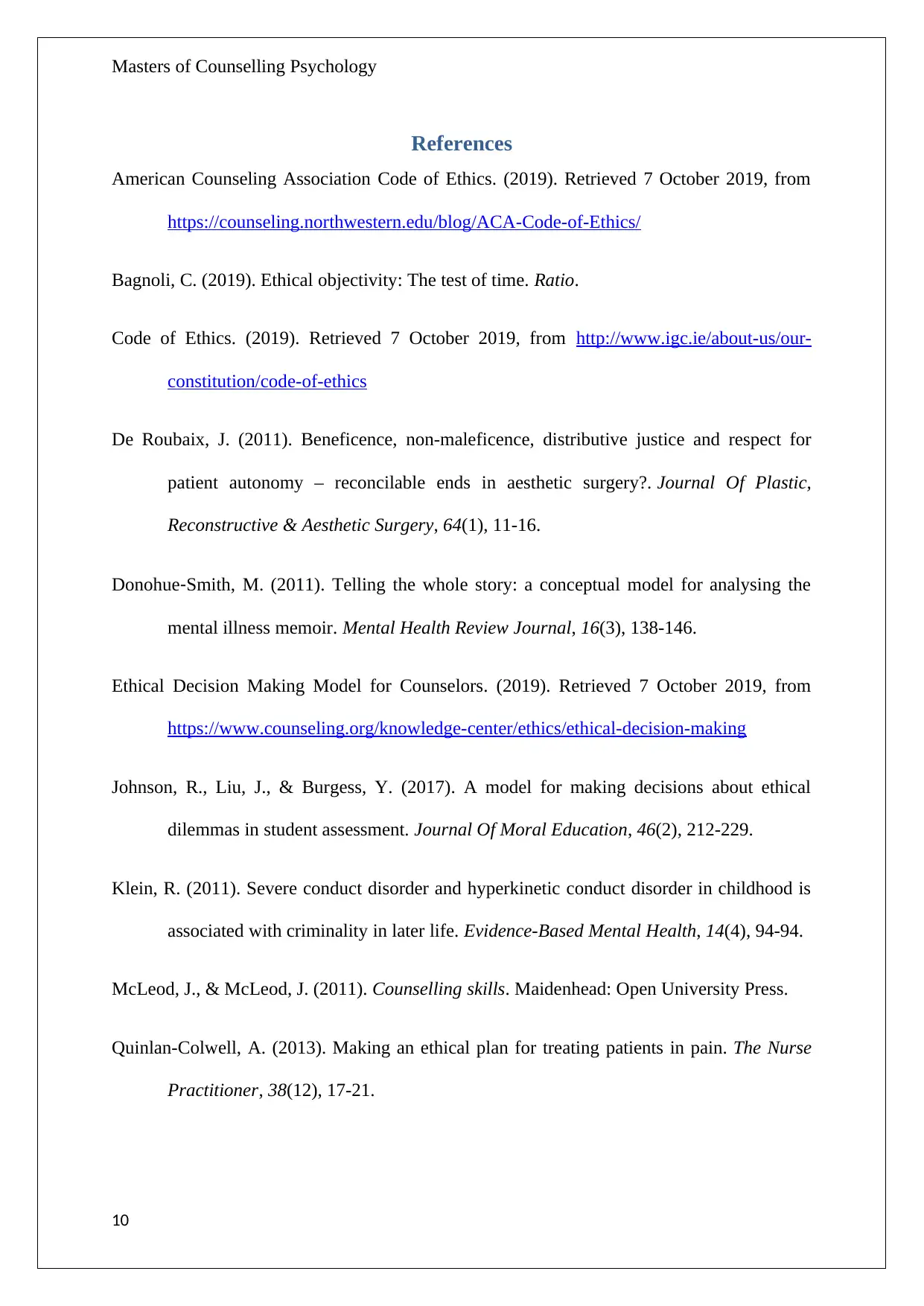
Masters of Counselling Psychology
References
American Counseling Association Code of Ethics. (2019). Retrieved 7 October 2019, from
https://counseling.northwestern.edu/blog/ACA-Code-of-Ethics/
Bagnoli, C. (2019). Ethical objectivity: The test of time. Ratio.
Code of Ethics. (2019). Retrieved 7 October 2019, from http://www.igc.ie/about-us/our-
constitution/code-of-ethics
De Roubaix, J. (2011). Beneficence, non-maleficence, distributive justice and respect for
patient autonomy – reconcilable ends in aesthetic surgery?. Journal Of Plastic,
Reconstructive & Aesthetic Surgery, 64(1), 11-16.
Donohue‐Smith, M. (2011). Telling the whole story: a conceptual model for analysing the
mental illness memoir. Mental Health Review Journal, 16(3), 138-146.
Ethical Decision Making Model for Counselors. (2019). Retrieved 7 October 2019, from
https://www.counseling.org/knowledge-center/ethics/ethical-decision-making
Johnson, R., Liu, J., & Burgess, Y. (2017). A model for making decisions about ethical
dilemmas in student assessment. Journal Of Moral Education, 46(2), 212-229.
Klein, R. (2011). Severe conduct disorder and hyperkinetic conduct disorder in childhood is
associated with criminality in later life. Evidence-Based Mental Health, 14(4), 94-94.
McLeod, J., & McLeod, J. (2011). Counselling skills. Maidenhead: Open University Press.
Quinlan-Colwell, A. (2013). Making an ethical plan for treating patients in pain. The Nurse
Practitioner, 38(12), 17-21.
10
References
American Counseling Association Code of Ethics. (2019). Retrieved 7 October 2019, from
https://counseling.northwestern.edu/blog/ACA-Code-of-Ethics/
Bagnoli, C. (2019). Ethical objectivity: The test of time. Ratio.
Code of Ethics. (2019). Retrieved 7 October 2019, from http://www.igc.ie/about-us/our-
constitution/code-of-ethics
De Roubaix, J. (2011). Beneficence, non-maleficence, distributive justice and respect for
patient autonomy – reconcilable ends in aesthetic surgery?. Journal Of Plastic,
Reconstructive & Aesthetic Surgery, 64(1), 11-16.
Donohue‐Smith, M. (2011). Telling the whole story: a conceptual model for analysing the
mental illness memoir. Mental Health Review Journal, 16(3), 138-146.
Ethical Decision Making Model for Counselors. (2019). Retrieved 7 October 2019, from
https://www.counseling.org/knowledge-center/ethics/ethical-decision-making
Johnson, R., Liu, J., & Burgess, Y. (2017). A model for making decisions about ethical
dilemmas in student assessment. Journal Of Moral Education, 46(2), 212-229.
Klein, R. (2011). Severe conduct disorder and hyperkinetic conduct disorder in childhood is
associated with criminality in later life. Evidence-Based Mental Health, 14(4), 94-94.
McLeod, J., & McLeod, J. (2011). Counselling skills. Maidenhead: Open University Press.
Quinlan-Colwell, A. (2013). Making an ethical plan for treating patients in pain. The Nurse
Practitioner, 38(12), 17-21.
10
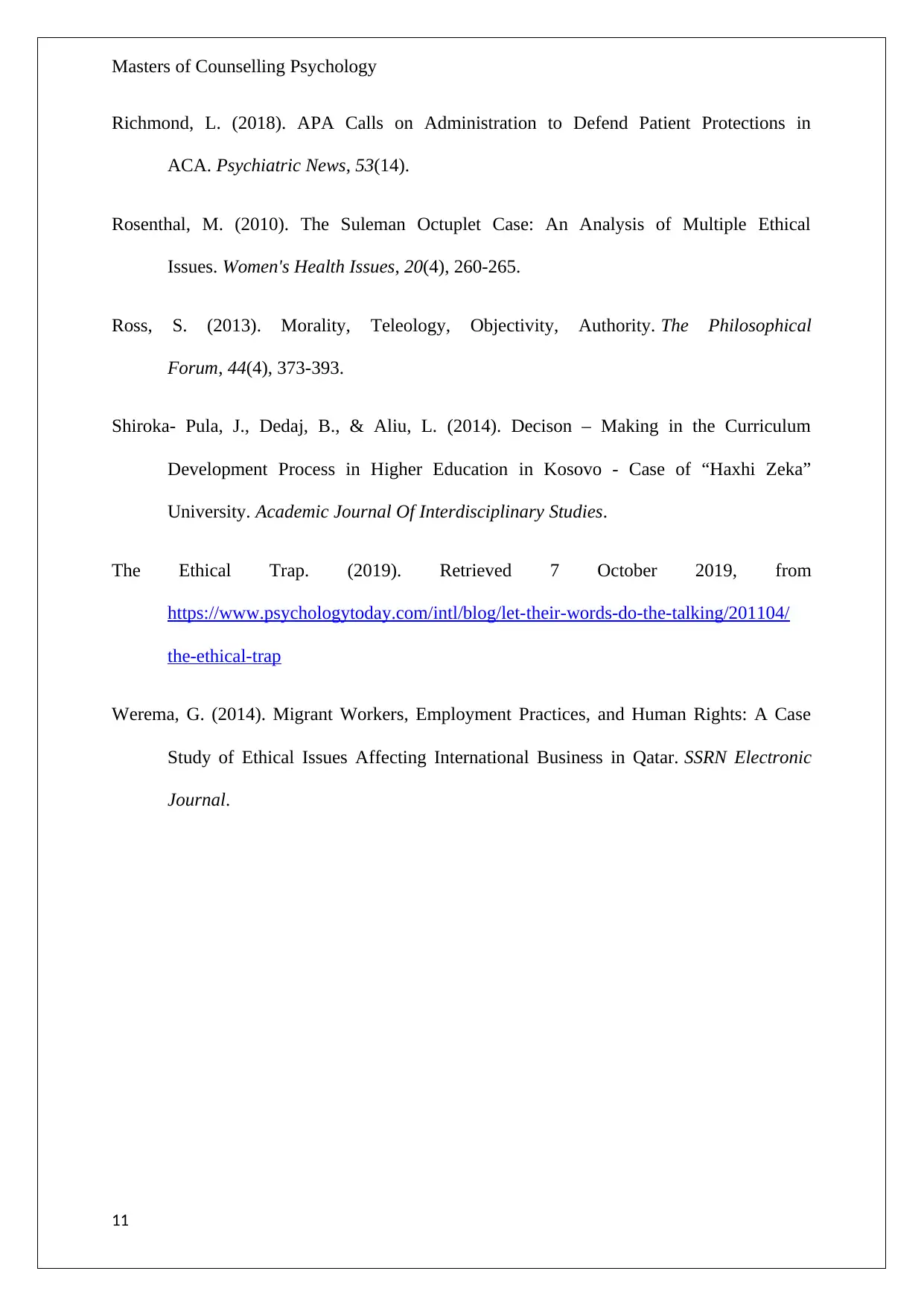
Masters of Counselling Psychology
Richmond, L. (2018). APA Calls on Administration to Defend Patient Protections in
ACA. Psychiatric News, 53(14).
Rosenthal, M. (2010). The Suleman Octuplet Case: An Analysis of Multiple Ethical
Issues. Women's Health Issues, 20(4), 260-265.
Ross, S. (2013). Morality, Teleology, Objectivity, Authority. The Philosophical
Forum, 44(4), 373-393.
Shiroka- Pula, J., Dedaj, B., & Aliu, L. (2014). Decison – Making in the Curriculum
Development Process in Higher Education in Kosovo - Case of “Haxhi Zeka”
University. Academic Journal Of Interdisciplinary Studies.
The Ethical Trap. (2019). Retrieved 7 October 2019, from
https://www.psychologytoday.com/intl/blog/let-their-words-do-the-talking/201104/
the-ethical-trap
Werema, G. (2014). Migrant Workers, Employment Practices, and Human Rights: A Case
Study of Ethical Issues Affecting International Business in Qatar. SSRN Electronic
Journal.
11
Richmond, L. (2018). APA Calls on Administration to Defend Patient Protections in
ACA. Psychiatric News, 53(14).
Rosenthal, M. (2010). The Suleman Octuplet Case: An Analysis of Multiple Ethical
Issues. Women's Health Issues, 20(4), 260-265.
Ross, S. (2013). Morality, Teleology, Objectivity, Authority. The Philosophical
Forum, 44(4), 373-393.
Shiroka- Pula, J., Dedaj, B., & Aliu, L. (2014). Decison – Making in the Curriculum
Development Process in Higher Education in Kosovo - Case of “Haxhi Zeka”
University. Academic Journal Of Interdisciplinary Studies.
The Ethical Trap. (2019). Retrieved 7 October 2019, from
https://www.psychologytoday.com/intl/blog/let-their-words-do-the-talking/201104/
the-ethical-trap
Werema, G. (2014). Migrant Workers, Employment Practices, and Human Rights: A Case
Study of Ethical Issues Affecting International Business in Qatar. SSRN Electronic
Journal.
11
⊘ This is a preview!⊘
Do you want full access?
Subscribe today to unlock all pages.

Trusted by 1+ million students worldwide
1 out of 12
Related Documents
Your All-in-One AI-Powered Toolkit for Academic Success.
+13062052269
info@desklib.com
Available 24*7 on WhatsApp / Email
![[object Object]](/_next/static/media/star-bottom.7253800d.svg)
Unlock your academic potential
Copyright © 2020–2025 A2Z Services. All Rights Reserved. Developed and managed by ZUCOL.




